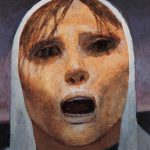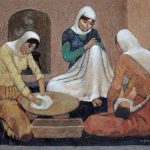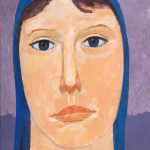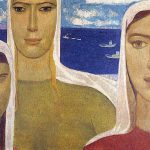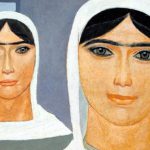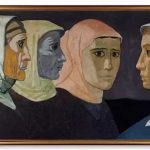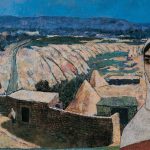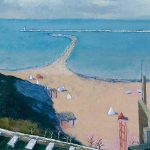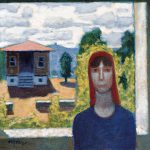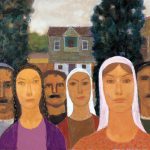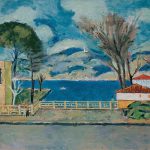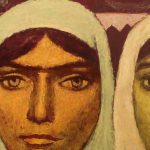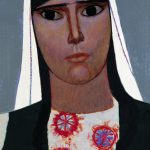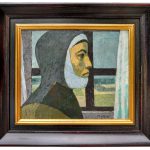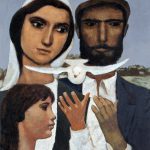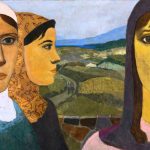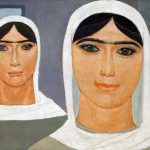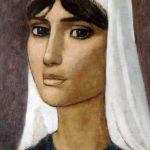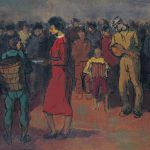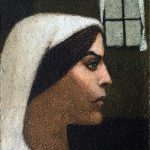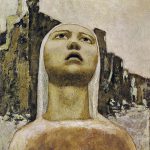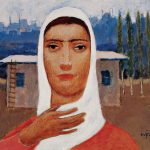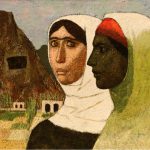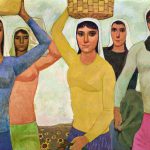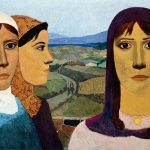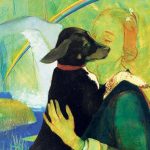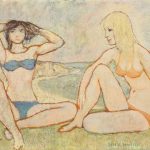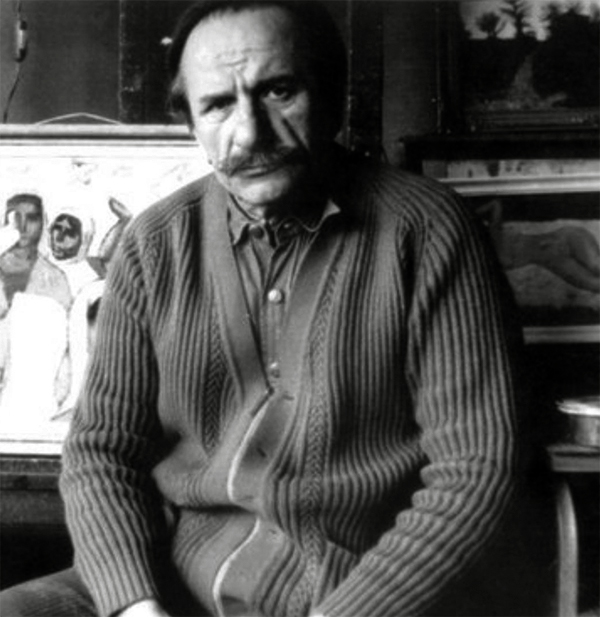
Who is Nuri İyem? (1915 Aksaray – 2005 Istanbul)
Nuri İyem is a Turkish painter and one of the leading names of the social-realist art movement. She is known for her portraits of Anatolian women. There are around 3500 images. In 1941, he formed the “Yeniler” group together with Avni Arbaş, Agop Arad, Turgut Atalay, Haşmet Akal, Kemal Sönmezler, Selim Turan, Fethi Karakaş, Ferruh Başağa, Mümtaz Yener and revealed his view of social-realist art with an exhibition called “Liman”. .
In 1918, when he was only three years old, he went to Cizre, a district of Mardin, with his mother and older sister, where his father was on duty. In 1922, she lost her sister, whose eyes would be the subject of portraits of her artistic life in the following years and who took a very close interest in her. She started primary school in Mardin.
From Istanbul, where she came with her family, she went to Shkodra, Albania, with her mother and aunt in 1923, where she attended the neighborhood school and then the Italian Primary School. Nuri İyem, who studied secondary school in Istanbul, where he returned, showed the paintings he made while he was a student at Pertevniyal High School to the Academy teacher of the time, Nazmi Ziya Güran, and received a response that he could be accepted into the Academy.
He entered the Academy in 1933 and became a student of Nazmi Ziya Güran in the first year of his education. In later years, she worked with Hikmet Onat, İbrahim Çallı and Leopold Levy. He took aesthetics lessons from Ahmet Hamdi Tanpınar, who would become his close friend in later years. He graduated in 1937, sharing first place with his classmate Ragıp Gürcan.
In 1938, that is, during World War II. He went to Thrace as a second lieutenant during World War II. After completing his military service, he was appointed as an art teacher in Giresun. He returned to the school he graduated from in 1940 to study in the "Department of Higher Painting". He became a student of Leopold Levy. The artist, who graduated from the "Department of Higher Painting" in 1944 as the first graduate with the first place for the second time with his work titled Nalbant, married Nasip Özçapan in the same year.
In 1941, he became the founder of the Yeniler Group with his friends such as Avni Arbaş, Agop Arad, Turgut Atalay, Haşmet Akal, Kemal Sönmezler, Selim Turan, Fethi Karakaş, Ferruh Başağa and Mümtaz Yener, with whom he shared his socialist-realist understanding of art. The group opened its first exhibition with the theme "Port City Istanbul" in the Beyoğlu General Directorate of Press building. He founded Turkey's first private painting class together with Fethi Karakaş and Ferruh Başağa in the attic of Beyoğlu Asmalımescit S. Önay Apartment. He witnessed that the students who graduated from here formed a group called Attic Painters in the following years.
Women's faces, which Ahmet Hamdi Tanpınar calls "tight as a statue, as elegant as the green moonlight, as simple as old frescoes and icons that carry the atmosphere of the past, are the product of a period when migration from villages to cities intensified and individual social rights operated against women." These faces, with their mahur, timid, beautiful, shy and melancholic states, are a crystallized example of Nuri İyem's art, both as the imaginary image of his deceased sister and as an iconic symbol that transcends time. In the 'migration' paintings that the artist painted around the same time, in which he approached the Anatolian reality with a nationalist perspective, women who worked and extracted their labor from the land were symbolized.
The artist's art, which was shaped under two periods: dimensional and post-abstract, formed its identity on an option opposed to academy-centered art views. In 2001, Evin Art Gallery identified the collections containing his paintings and archived the images. As a continuation of the project, the artist, whose Retrospective exhibition "From Past to Tomorrow Nuri İyem" consisting of 1504 paintings was opened and a two-volume book containing all the works included in the exhibition was published, passed away on June 18, 2005, at the age of 90, at his home in Ulus.
The artist, who was buried in Zincirlikuyu Cemetery, had a photograph of the artist in front of a painting themed "Anatolian Women" worn on the collars of those who attended the funeral, including her artist husband and life partner Nasip İyem.
passion for painting
He describes his passion for painting and his parents' attitude towards him in his own words:
First, I need to start with the slaps I received from my father because of my passion for painting: I was in primary school in Mardin. One holiday day, I was drawing with colored pencils at home. Since the colored pencils we used at that time were of poor quality, their tips broke quickly. I was trying to open the broken ends with an old pocket knife. But it was very difficult to whittle the pencils. At that moment, my father's razors, which were in a box in a cabinet built into the wall, came to my mind. I also knew you hadn't used those razors in a long time. But I was afraid to pick up the razors. Of course, it was easier for me to buy it when my father was not at home and when he went to the barber. With razors, I could more easily sharpen pencils whose colored tips were breaking. I could carve, but the sharp edges of the razors broke quickly. After painting, I put the razors in the box and put them in the closet. I was waiting for the storm to break. When I remember these things now, it seems like only a month or two have passed since what happened. My father opened the closet door, stood in front of it with razors in his hands and was calling me. When I went to him, he started slapping me without saying anything. When he thought he had slapped me enough, he asked me why I had brought the razors to this point. I told the incident as it happened. I told him that I had seen the razors a long time ago, that I never thought they would break so easily when sharpening the tips of the pencils, and that I thought it was not necessary since he did not use them either. I don't remember now what happened to the painting I made using my father's razors. But painting was such an exciting and enjoyable thing. Archived 18 December 2007 at the Wayback Machine.
Selections from his posthumous exhibitions
2005: Arti Mezat
2005: Arti Mezat
2005: Evin Art Gallery
2006: Cumalı Art Gallery
2006: Evin Art Gallery
2007: Antik Park Fine Art and Antiques
2007: Doku Art Gallery
2007: Evin Art Gallery
2007: Evin Art Gallery, Artist 2007, Tüyap-Istanbul
2007: March Collection
2007: Rezan Has Museum
2007: Valör Art Gallery, Artistanbul 2007, Istanbul
2008: Antik Park Fine Art and Antiques
2008: Depths Art Center
2008: Doku Art Gallery
2008: Evin Art Gallery
2008: Olcay Art
His exhibitions a year before his death
2004: Island Antique
2004: Cream Art Gallery
2004: Evin Art Gallery
2004: Gallery Ortaköy
2004: Nurol Art Gallery
Awards
1973: 50th Anniversary of the Republic Painting Award
1989: Sedat Simavi Visual Arts Award
1997: Tüyap Istanbul Art Fair Honor Award
